Is infectious abortion causing serious losses on your farm? Every lamb lost potentially costs you approximately €100 in lost sales. Some veterinary experts suggest that an outbreak of infectious abortion can result in losses of up to 40% of the lamb crop.
This amounts to a loss of 60 lambs or €5,000 to €6,000 in lost sales in a flock of 100 ewes targeting to wean 1.5 lambs per ewe mated. Further costs include loss of young ewes from the flock, veterinary bills, disposal of carcases as well as a lot of stress. Can you afford to ignore this risk? You must take a strategic approach to address this issue on your farm.
Causes of abortion
Ewes may lose a pregnancy any time from conception to lambing. Lambs can be aborted in the days, weeks or months before lambing and may go unnoticed until ewes show up as barren at scanning or at lambing time. Lambs that are born weak and die soon after birth may also be the result of an infective or causative abortion agent being present in the ewe. There are many potential causes of abortion.
However, at lambing time, if the proportion of losses from ewes that proved in-lamb at scanning is greater than 3%, consideration should be given to the possibility that these losses may be due to an infectious cause and this should be investigated.
Common causes
Data in Figure 1 shows that toxoplasmosis and enzootic abortion of ewes (EAE) are the most common causes of infectious abortion of sheep in Ireland.
Many of the infectious abortion agents are zoonotic, meaning that they can be transmitted to humans. They can cause flu-like symptoms in children and adults and if infection is transmitted to pregnant women it may lead to miscarriage of unborn babies. Therefore, precautions must be taken, such as wearing gloves when handling sheep during and after lambing. Pregnant women should completely avoid contact with sheep around lambing time.
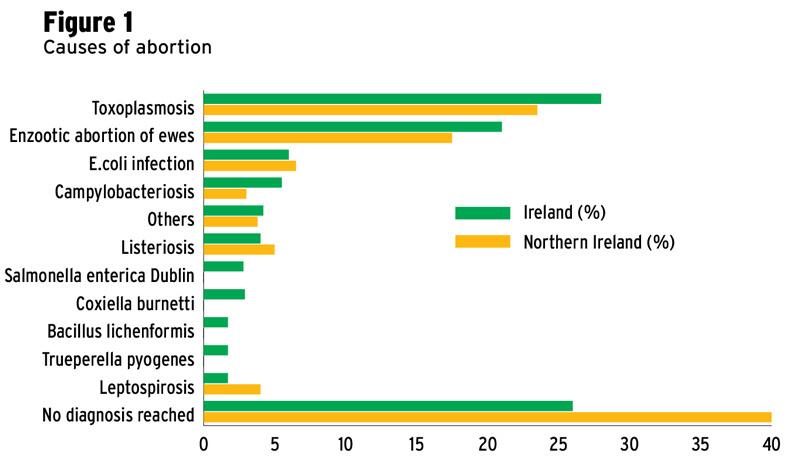
Investigating an abortion outbreak
All cases of abortion should be discussed with your veterinary practitioner. In order to investigate an abortion outbreak it is important to implement the following steps (listed in Figure 2):
Isolate suspect ewes and lambs to prevent spreading disease to other healthy sheep.At a minimum take a swab from the surface of the freshly aborted foetus and another from the aborted placenta and have these analysed in an approved laboratory. A kit containing two swabs for this procedure with instructions on how to take the samples can be obtained from your veterinary surgeon.In addition to the above, submit fresh aborted material, including foetuses and afterbirth, to your regional veterinary laboratory for investigation. This must be arranged with your veterinary surgeon before submitting material to the laboratory.Arrange for your veterinary surgeon to take blood samples from 20 suspect ewes and send these to the laboratory for analysis.Follow advice given by your veterinary surgeon based on the results of the investigation. Advice will vary depending on the known cause of the abortion outbreak.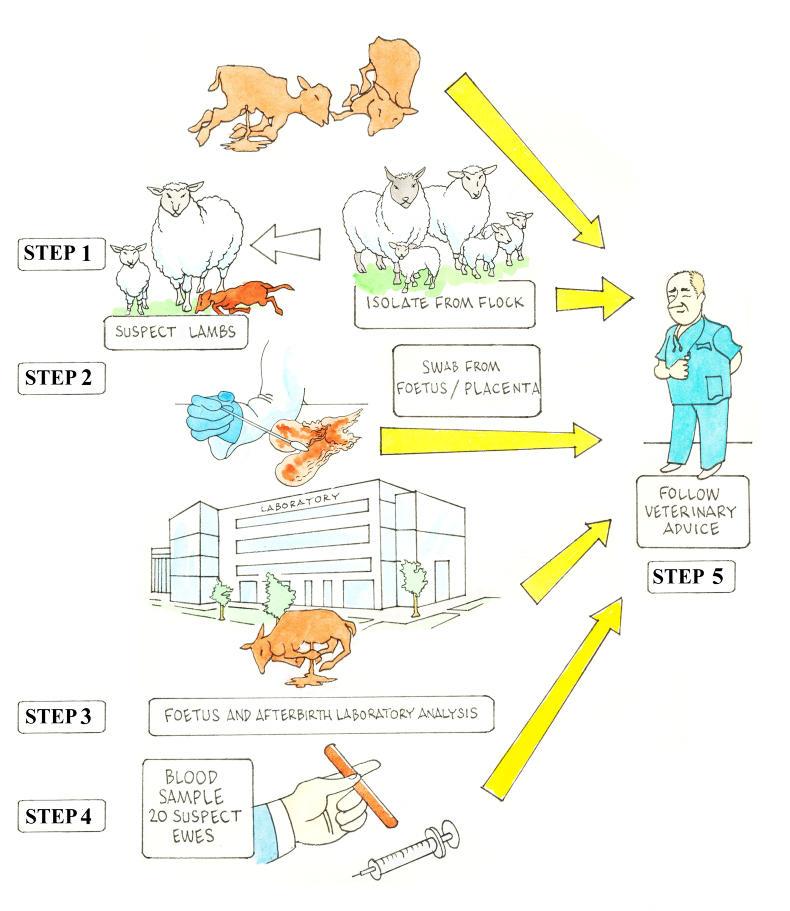
Does your sheep flock have the deadliest infection?
Enzootic abortion in ewes is caused by a bacterial-type organism called Chlamydophila abortus. It is one of the top two causes of infectious abortion on the island of Ireland. It is spread from sheep to sheep around lambing time. Healthy sheep, both young and old, can become infected at that time. The infection then lies dormant and goes unnoticed in what appear to be perfectly healthy sheep. A year or two later, when these sheep are in late pregnancy, the infection attacks the placenta and the ewe aborts her lambs. It can therefore cause major losses, can go unnoticed and is difficult to control. Farmers need to be very vigilant to protect their flocks.
Preventing EAE in a flock that is already free of the disease
If abortions remain below 3% in your flock, there is little reason to suspect EAE. Steps should be taken to protect your flock’s EAE free status for the future. The approach for disease prevention will be different for producers who breed their own replacements (ie maintain a closed flock) or buy their replacements.
Breeding your own replacements (best strategy)
Breeding your own replacements is the best option to prevent EAE on your farm. However, you should remain vigilant for signs of abortion and continue to operate a closed flock. Avoid buying foster ewes or pet lambs that may be carrying the disease. This will significantly reduce the risk of the disease being introduced to the flock.
Buying in replacements
As EAE is a disease that is introduced to your farm by other sheep, preventative biosecure measures are needed including:
Buy replacements from a reliable source that doesn’t have EAE in their flock.Vaccinate all bought in replacements against EAE at least four weeks before the start of the breeding season. As the vaccine is a live vaccine this must be pre-ordered through your veterinary surgeon so as to ensure timely vaccination. While vaccination significantly reduces the risk of the disease occurring, it does not completely eliminate the risk.Consider switching to breeding your own replacements for the future.Dealing with a confirmed case of EAE
Following confirmation from the investigations that EAE is present in your flock a number of measures are important including:
In the current year
Any ewes in the flock that are yet to lamb should be given a long acting antibiotic. This should be discussed and arranged with your veterinary surgeon. This will help reduce the number of abortions in the current year. It will not stop the outbreak completely and will not prevent ewes from being infective.Continue to isolate aborting ewes from the main flock.All suspect ewes should be prioritised for culling. This will help reduce the risk of spreading infection to healthy.All ewes remaining on the farm should be vaccinated at least four weeks before the next breeding season commences. However, if sheep are infected with EAE prior to vaccination, a small percentage may abort the following year due to latency.In subsequent years
Consider breeding your own replacements in the future.If purchasing replacements, make sure to buy from a reliable source.All replacements should be vaccinated at least four weeks before mating commences. This includes home bred and purchased replacements. Vaccination of replacements should be continued for several years following identification of EAE in the flock, at least until all sheep present at time of diagnosis, have left the flock.I wish to acknowledge a number of people who contributed to producing this article. These include my colleagues on the animal health working group led by Professor Michael Diskin including Teagasc colleagues, veterinary surgeons from the Regional Veterinary Laboratories, John Gilmore, Farm Lab Diagnostics, MSD, private veterinary practitioners and the Irish Farmers Journal.
Read more
Editorial: positive moves on sheep animal health
Special focus: lambing 2017
Is infectious abortion causing serious losses on your farm? Every lamb lost potentially costs you approximately €100 in lost sales. Some veterinary experts suggest that an outbreak of infectious abortion can result in losses of up to 40% of the lamb crop.
This amounts to a loss of 60 lambs or €5,000 to €6,000 in lost sales in a flock of 100 ewes targeting to wean 1.5 lambs per ewe mated. Further costs include loss of young ewes from the flock, veterinary bills, disposal of carcases as well as a lot of stress. Can you afford to ignore this risk? You must take a strategic approach to address this issue on your farm.
Causes of abortion
Ewes may lose a pregnancy any time from conception to lambing. Lambs can be aborted in the days, weeks or months before lambing and may go unnoticed until ewes show up as barren at scanning or at lambing time. Lambs that are born weak and die soon after birth may also be the result of an infective or causative abortion agent being present in the ewe. There are many potential causes of abortion.
However, at lambing time, if the proportion of losses from ewes that proved in-lamb at scanning is greater than 3%, consideration should be given to the possibility that these losses may be due to an infectious cause and this should be investigated.
Common causes
Data in Figure 1 shows that toxoplasmosis and enzootic abortion of ewes (EAE) are the most common causes of infectious abortion of sheep in Ireland.
Many of the infectious abortion agents are zoonotic, meaning that they can be transmitted to humans. They can cause flu-like symptoms in children and adults and if infection is transmitted to pregnant women it may lead to miscarriage of unborn babies. Therefore, precautions must be taken, such as wearing gloves when handling sheep during and after lambing. Pregnant women should completely avoid contact with sheep around lambing time.

Investigating an abortion outbreak
All cases of abortion should be discussed with your veterinary practitioner. In order to investigate an abortion outbreak it is important to implement the following steps (listed in Figure 2):
Isolate suspect ewes and lambs to prevent spreading disease to other healthy sheep.At a minimum take a swab from the surface of the freshly aborted foetus and another from the aborted placenta and have these analysed in an approved laboratory. A kit containing two swabs for this procedure with instructions on how to take the samples can be obtained from your veterinary surgeon.In addition to the above, submit fresh aborted material, including foetuses and afterbirth, to your regional veterinary laboratory for investigation. This must be arranged with your veterinary surgeon before submitting material to the laboratory.Arrange for your veterinary surgeon to take blood samples from 20 suspect ewes and send these to the laboratory for analysis.Follow advice given by your veterinary surgeon based on the results of the investigation. Advice will vary depending on the known cause of the abortion outbreak.
Does your sheep flock have the deadliest infection?
Enzootic abortion in ewes is caused by a bacterial-type organism called Chlamydophila abortus. It is one of the top two causes of infectious abortion on the island of Ireland. It is spread from sheep to sheep around lambing time. Healthy sheep, both young and old, can become infected at that time. The infection then lies dormant and goes unnoticed in what appear to be perfectly healthy sheep. A year or two later, when these sheep are in late pregnancy, the infection attacks the placenta and the ewe aborts her lambs. It can therefore cause major losses, can go unnoticed and is difficult to control. Farmers need to be very vigilant to protect their flocks.
Preventing EAE in a flock that is already free of the disease
If abortions remain below 3% in your flock, there is little reason to suspect EAE. Steps should be taken to protect your flock’s EAE free status for the future. The approach for disease prevention will be different for producers who breed their own replacements (ie maintain a closed flock) or buy their replacements.
Breeding your own replacements (best strategy)
Breeding your own replacements is the best option to prevent EAE on your farm. However, you should remain vigilant for signs of abortion and continue to operate a closed flock. Avoid buying foster ewes or pet lambs that may be carrying the disease. This will significantly reduce the risk of the disease being introduced to the flock.
Buying in replacements
As EAE is a disease that is introduced to your farm by other sheep, preventative biosecure measures are needed including:
Buy replacements from a reliable source that doesn’t have EAE in their flock.Vaccinate all bought in replacements against EAE at least four weeks before the start of the breeding season. As the vaccine is a live vaccine this must be pre-ordered through your veterinary surgeon so as to ensure timely vaccination. While vaccination significantly reduces the risk of the disease occurring, it does not completely eliminate the risk.Consider switching to breeding your own replacements for the future.Dealing with a confirmed case of EAE
Following confirmation from the investigations that EAE is present in your flock a number of measures are important including:
In the current year
Any ewes in the flock that are yet to lamb should be given a long acting antibiotic. This should be discussed and arranged with your veterinary surgeon. This will help reduce the number of abortions in the current year. It will not stop the outbreak completely and will not prevent ewes from being infective.Continue to isolate aborting ewes from the main flock.All suspect ewes should be prioritised for culling. This will help reduce the risk of spreading infection to healthy.All ewes remaining on the farm should be vaccinated at least four weeks before the next breeding season commences. However, if sheep are infected with EAE prior to vaccination, a small percentage may abort the following year due to latency.In subsequent years
Consider breeding your own replacements in the future.If purchasing replacements, make sure to buy from a reliable source.All replacements should be vaccinated at least four weeks before mating commences. This includes home bred and purchased replacements. Vaccination of replacements should be continued for several years following identification of EAE in the flock, at least until all sheep present at time of diagnosis, have left the flock.I wish to acknowledge a number of people who contributed to producing this article. These include my colleagues on the animal health working group led by Professor Michael Diskin including Teagasc colleagues, veterinary surgeons from the Regional Veterinary Laboratories, John Gilmore, Farm Lab Diagnostics, MSD, private veterinary practitioners and the Irish Farmers Journal.
Read more
Editorial: positive moves on sheep animal health
Special focus: lambing 2017









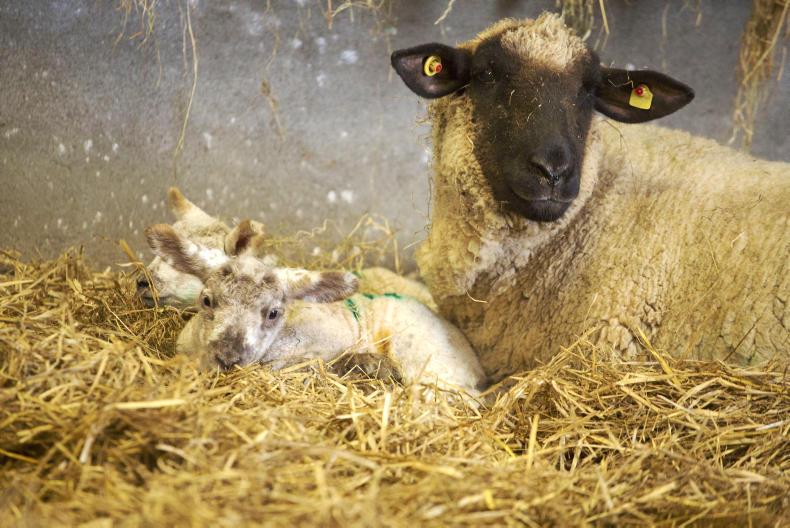
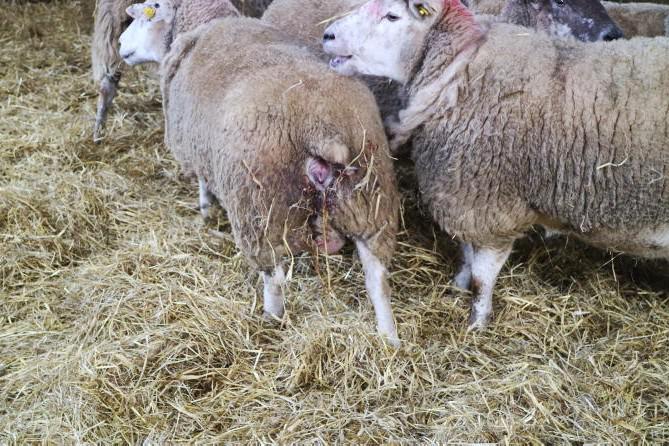


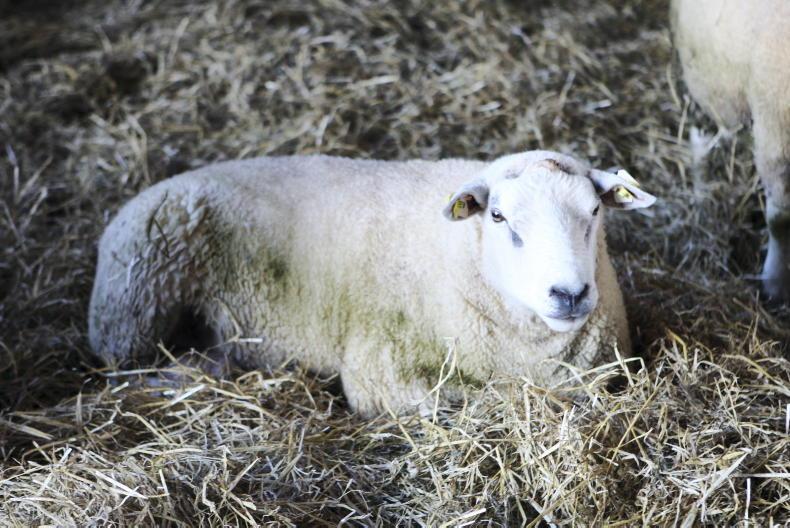

SHARING OPTIONS